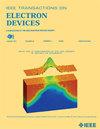绝对电致发光成像揭示多结太阳能电池的退化
IF 3.2
2区 工程技术
Q2 ENGINEERING, ELECTRICAL & ELECTRONIC
引用次数: 0
摘要
多结太阳能电池(MJSCs)在长期储存过程中经历了材料降解和效率降低。目前针对III-V型复合MJSCs的缺陷分析方法由于缺乏直观的工具和深入的理解而受到限制,阻碍了收率和效率的提高。绝对电致发光(EL)是太阳能电池性能可视化和预测的有力技术。在这项研究中,我们使用绝对EL来量化储存26个月后亚细胞的性能和降解机制。绝对电成像确定了亚细胞内潜在的和固有的缺陷类型。局部缺陷点的详细分析表明,缺陷点附近的光子发射减少。利用互易定理和载流子平衡模型,我们发现InGaP/GaAs/InGaAs太阳能电池的退化导致效率降低0.8%,主要是由于非辐射复合(NR)损失。此外,顶部、中间和底部电池的效率分别下降了0.3%、0.2%和0.3%。这项工作表明,绝对电致发光成像技术为了解MJSC长期储存过程中的缺陷和能量损失提供了一种全面而详细的方法。本文章由计算机程序翻译,如有差异,请以英文原文为准。
Degradations of Multijunction Solar Cell Revealed by Absolute Electroluminescence Imaging
Multijunction solar cells (MJSCs) experience material degradation and reduced efficiency during long-term storage. Current defect analysis methods for III-V compound MJSCs are limited by a lack of intuitive tools and in-depth understanding, hindering improvements in yield and efficiency. Absolute electroluminescence (EL) is a powerful technique for visualization and predicting solar cell performance. In this study, we applied absolute EL to quantify performance and degradation mechanisms in subcells after 26 months of storage. Absolute EL imaging identified both potential and inherent defect types within the subcells. The detailed analysis of localized defect points showed reduced photon emission near the defect points. Using the reciprocity theorem and carrier balance model, we found that degradation in the InGaP/GaAs/InGaAs solar cell resulted in a 0.8% reduction in efficiency, largely due to nonradiative recombination (NR) losses. Additionally, the efficiencies of top, middle, and bottom cells decreased by reduced by 0.3%, 0.2%, and 0.3%, respectively. This work demonstrates that the absolute EL imaging technique provides a comprehensive and detailed method for understanding defects and energy losses during long-term storage in MJSC.
求助全文
通过发布文献求助,成功后即可免费获取论文全文。
去求助
来源期刊

IEEE Transactions on Electron Devices
工程技术-工程:电子与电气
CiteScore
5.80
自引率
16.10%
发文量
937
审稿时长
3.8 months
期刊介绍:
IEEE Transactions on Electron Devices publishes original and significant contributions relating to the theory, modeling, design, performance and reliability of electron and ion integrated circuit devices and interconnects, involving insulators, metals, organic materials, micro-plasmas, semiconductors, quantum-effect structures, vacuum devices, and emerging materials with applications in bioelectronics, biomedical electronics, computation, communications, displays, microelectromechanics, imaging, micro-actuators, nanoelectronics, optoelectronics, photovoltaics, power ICs and micro-sensors. Tutorial and review papers on these subjects are also published and occasional special issues appear to present a collection of papers which treat particular areas in more depth and breadth.
 求助内容:
求助内容: 应助结果提醒方式:
应助结果提醒方式:


